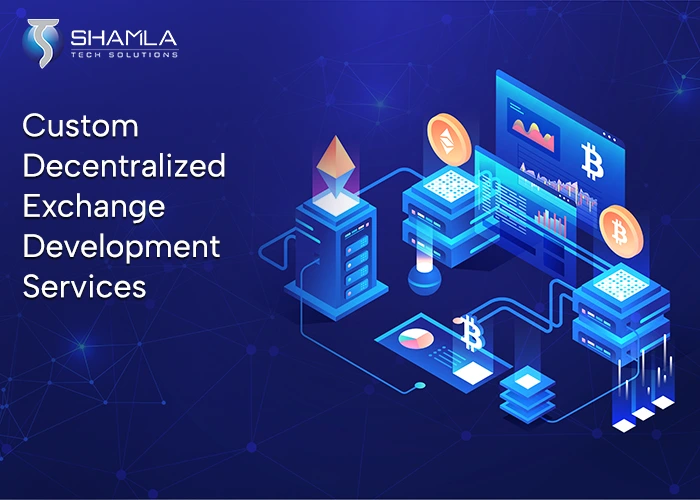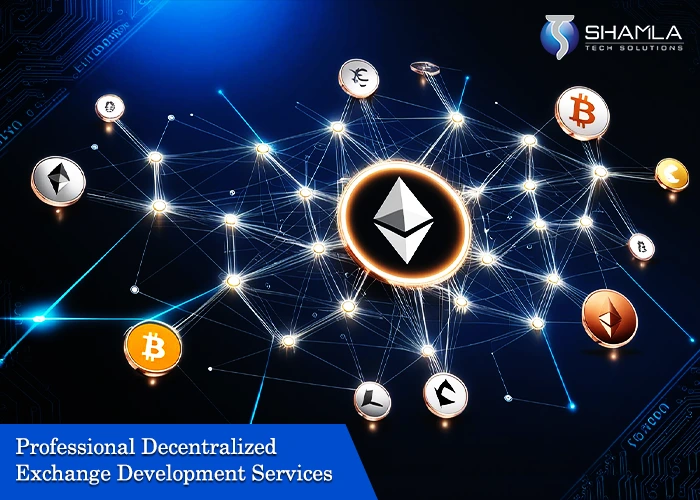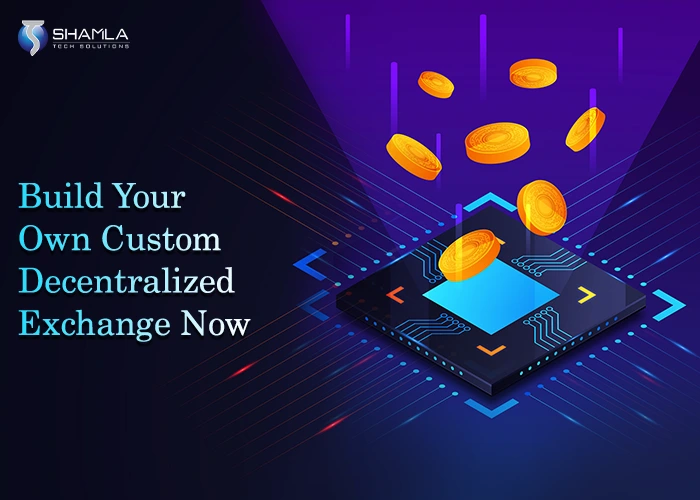Developing your own decentralized exchange is definitely a groundbreaking step into the future of cryptocurrency trading. As the demand for secure and user-friendly decentralized exchange platforms continues to grow day by day, businesses and individual visionaries are finding ways to create their own decentralized exchange.
In this article we will walk you through all the essentials needed to create your own cryptocurrency exchange that is decentralized. To make all this easier, you can get the expertise from a custom blockchain development company or hire blockchain developers, through which you can create your own decentralized exchange that stands out with many unique functionalities that aren’t found in other exchanges.

What is a Decentralized Exchange (DEX)?
A decentralized exchange (DEX) is a type of cryptocurrency trading platform that works without a central authority. It lets its users to easily trade in a direct manner with each other using smart contracts that run on a blockchain. In a centralized exchange there are a lot of middlemen involved which can lead to the compromise in both security and time. To make this work in an efficient way DEX removes the entire need for all kinds of middlemen, which gives its users with more security and privacy. If you want to create your own decentralized exchange, the first step for you would be to understand how these exchanges actually work.
In order to create your own decentralized exchange and achieve success with it will not just lie in the process of building the trading platform, it will also depend on how safe and smooth of an experience that you provide to your users with your platform. You’ll need to create a cryptocurrency exchange that can support multiple tokens, easy-to-use interfaces, and you should also consider to create a crypto wallet for users to easily manage their assets. All these parts are very important for giving users a great and unique trading experience.

10 Easy Steps to Create Your Own Decentralized Exchange
1. Define Your DEX’s Unique Value Proposition
To define your DEX’s unique value, you need to look closely at existing platforms and find areas where improvements can be made. Focus on solving common problems like high gas fees, liquidity issues, and poor user experience. By using modern blockchain solutions, like Layer-2 protocols, you can lower transaction costs and make the platform faster. To create your own decentralized exchange, you should also integrate features like gasless transactions, automatic market-making (AMM) systems, or advanced order types. Adding a strong liquidity pool structure with rewards for liquidity providers (LPs) and yield farming will help bring in capital and make sure there’s enough liquidity on the platform. Giving people control over decisions through decentralized autonomous organizations (DAOs) will also help with platform upgrades.
Consider integrating with newer or less popular blockchain systems, such as Solana or Avalanche. This can help you stand out from other platforms focused mainly on Ethereum and Binance Smart Chain (BSC). Cross-chain functionality should be a priority, letting users easily trade assets across different networks. By creating a multi-chain DEX, you can reach users from different ecosystems, which will boost adoption. To do this, you should use bridging solutions and protocols like Polkadot or Cosmos to make cross-chain asset transfers smooth and secure. Make sure to protect these features by using strong cryptographic protocols to keep user data and funds safe.
To attract big investors and fast traders, focus on improving liquidity and reducing slippage. Using order book models with AMM will allow both automated trading and traditional limit orders, giving traders more choices. Adding features like on-chain price data, advanced charting tools, and real-time analytics will improve your platform’s appeal. You should also add risk management tools to reduce exposure to impermanent loss and protect against price manipulation. Make sure your platform is scalable enough to handle large trades, especially during busy times. Keeping latency low will improve trading efficiency and stability.
Security should be a top priority for your DEX. Make sure to do smart contract audits, set up bug bounty programs, and use multi-signature wallets to stop unauthorized access. Go further by adding features like transaction batching and state channels to increase privacy and lower fees. Adding decentralized identity (DID) solutions will improve security by reducing the need for centralized identity providers. It’s also important to stay compliant with regulations while maintaining decentralization by letting the community have a say in decisions. Being transparent about security and risk management will help build trust and make your platform more reliable in the competitive DEX market.
2. Understand the Legal and Regulatory Landscape
DEXs actually work in a complex and quickly changing regulatory environment too, with different countries taking their own different approaches to cryptocurrency and blockchain technology. Regulations now are usually focused on things like anti-money laundering (AML), know-your-customer (KYC) rules, taxes, and how these digital assets are being classified. In some countries, decentralized platforms may also be closely watched because of their ability to follow financial rules that also apply to centralized exchanges. It’s very important for you to keep up with local, national, and international rules that may affect DEX operations.
AML and KYC rules are two of the biggest concerns for DEXs. While decentralized exchanges reduce the need for traditional middlemen, governments are pushing for more transparency and accountability. Some countries may require DEX operators to follow AML and KYC rules, which can go against the decentralized idea behind these platforms. But not following these rules can lead to serious consequences, including big fines or even shutting down the platform. To solve this problem, DEXs can look into using decentralized identity solutions, which would let users stay compliant without giving up their privacy. Finding a balance between protecting user privacy and following the rules is one of the hardest challenges for DEX developers.
Taxation is another complex issue, as different countries treat cryptocurrencies as taxable assets, subject to capital gains tax, value-added tax (VAT), and other taxes. DEXs must find ways to track and report taxable events, especially if they handle a high volume of transactions. Developers need to add tax-reporting features that comply with local regulations, helping users report their profits and losses accurately. As tax laws for cryptocurrencies evolve, it’s essential for DEXs to stay informed and adjust the platform’s rules accordingly. In response to the changing landscape, some platforms may consider ways to create a cryptocurrency coin that simplifies tax reporting and ensures compliance with diverse taxation systems.
Regulatory bodies are always changing how they view digital assets. So, it’s important for DEX operators to keep ahead of these changes to avoid legal problems in the future. International groups, like the Financial Action Task Force (FATF), are giving advice on how digital assets should be controlled. The U.S. and the European Union are working on new rules to address decentralized finance (DeFi), including DEXs. Being ready for these changes is important to avoid legal issues later. Legal teams need to stay in touch with regulators to make sure the platform follows new rules and stays legal in the fast-changing world of digital finance.
3. Choose the Right Block chain for Your DEX
The blockchain you choose for your exchange will directly affect your platform’s scalability, security, transaction speed, and user experience. Ethereum is the most commonly used blockchain for decentralized exchanges, the strong ecosystem it has, large developer community being available, and support for smart contracts using Solidity make it the best option. However, its high and often changing gas fees, along with the frequent network delays, can actually limit how many users adopt it.
Transaction speed and scalability are very important when picking the right blockchain. Blockchains like Ethereum, while being very secure and trusted, often face big problems with how many transactions they can handle and how fast they can go. This can cause delays and expensive fees, especially when the network is very busy. Layer-2 solutions, like Optimistic Rollups or zk-Rollups, can help Ethereum by handling transactions off-chain and sending only the final results on-chain, making things more efficient. On the other hand, blockchains like Solana, Binance Smart Chain (BSC), and Avalanche offer much faster transaction speeds, lower fees, and can handle more transactions, making them great options for decentralized exchange platforms that focus on good performance, low costs, and smooth user experience.
Interoperability is also another parameter to consider with high magnitude when you want to choose the best blockchain for your platform. DEXs usually need to support cross-chain swaps so users can easily trade assets between different blockchain networks. To make sure everything works smoothly, it’s best to choose blockchains that either have built-in cross-chain compatibility or support solutions for connecting different blockchains. Blockchains like Polkadot and Cosmos are precisely made for working together between chains, allowing your DEX to offer support to many different digital assets across various systems. This cross-chain ability will make sure that your platform can easily attract users from many different blockchain communities and provide them with more trading options.
A secure blockchain, with a trusted and proven way to agree on transactions, like Ethereum’s Proof of Stake (PoS) or Solana’s Proof of History (PoH), will work best for you to keep all the users’ funds safe and also to make sure that users can actually trust your platform. Also, it’s super important to think about how well decentralized the network actually is. Blockchains that have a highly decentralized structure can easily reduce the risk of having a single point of failure, making them much stronger against attacks and censorship. To achieve this level of security and decentralization, working with a custom blockchain development company can help to make sure that your platform is built on a robust and trusted blockchain.

4. Decide on the Type of DEX You Want to Build
The type of DEX you wish to build will completely shape the total working of it and the experience that it provides for your users. There are 3 major types to consider, namely, Automated Market Maker (AMM), Order Book DEX, and Hybrid DEX. Out of all these, AMMs are considered to be the best choice as they can let your users easily trade assets through liquidity pools, instead of the need of matching to buy and sell the order by themselves. They make use of algorithms like Constant Product Market Makers (CPMM) to figure out the prices and maintain the ongoing liquidity. One more cool thing about them is that they are super simple to set up and they also give low slippage, which makes them an overall good choice for most of the DEX platforms. If you’re wondering how to build a decentralized exchange like Uniswap, you can put your focus on AMM models which can be a great starting point due to their simplicity and efficiency.
On the other hand, Order Book DEXs work like traditional exchanges, where buyers and sellers place their orders, and these orders match based on price and time priority. These exchanges need strong systems to handle fast transactions, limit orders, and matching orders. While Order Book DEXs give more control and precision in trading, they generally need more computing power and a more complicated system. They also tend to have slower speeds compared to AMMs, which can affect the user experience, especially when the market is very active. However, their extra features like margin trading and limit orders appeal to professional traders and big investors who want more control.
Hybrid DEXs mix the best parts of both AMMs and Order Book DEXs. They offer the flexibility of order books while still using liquidity pools. This type will mostly use liquidity pools for trades but will also allow for limit orders, giving users a more traditional trading experience. Hybrid models give more trading options and can improve liquidity by combining both systems. However, they need more complex smart contracts and backend systems, and also need extra security to make sure everything works well and safely.
The type of DEX you choose depends mainly on your target audience and what kind of trading experience you want to provide. If your main goal is to offer a fast, easy, and low-cost option for regular users, an AMM-based platform might be the best choice. However, if you’re looking for affordable cryptocurrency development services, we offer crypto exchange development solutions that can help to create instant cryptocurrency exchanges that can be efficient and cost-effective. On the other hand, if you’re aiming to attract big traders or professional investors who want more control and features like limit orders and detailed charts, then an Order Book DEX could be a better fit. Hybrid DEXs also work well for both casual traders and experienced users. In the end, the model you choose will affect your platform’s features, its user interface, and its ability to grow in the future.
5. Develop or Acquire the Necessary Smart Contracts
Developing the correct smart contracts will be a very important step in the process to create your own decentralized exchange, these smart contracts are pieces of codes that run on the blockchain network to carry out the transaction and follow the rules that have been set up without any need of middlemen to monitor them and the best part is that these will be done automatically too, making this much easier for you. The main smart contracts for a DEX will include liquidity pool contacts, token swap contracts, and governance contracts. All these smart contacts will handle the simple and basic tasks like processing trades, managing liquidity pools, and helping with decentralized decision-making too. When creating these smart contracts, you must make sure they are secure, work well, and are fully tested to avoid any weaknesses or problems that could put users’ funds and the platform’s safety at risk.
Liquidity pool smart contracts are the core part of the Automated Market Makers (AMMs). These contracts help to create and manage liquidity pools by allowing users to add pairs of tokens into a smart contract. In return, users get liquidity provider (LP) tokens, which show their share of the pool. The smart contract automatically changes asset prices based on the ratio of tokens in the pool. Liquidity pool contracts need to be optimized for gas efficiency and to ensure that slippage stays low, especially when big transactions happen. It’s very important to test and check these contracts to make sure they work correctly and the prices are fair. If you’re in the pursuit of knowing how to create a P2P crypto exchange that stands out, it is important that liquidity pool smart contracts are optimized and well-tested.
Token swap smart contracts allow users to trade on the platform. In an AMM-based DEX, token swap contracts automatically match trades between the user and the liquidity pool. These contracts should be made to be very efficient, reducing transaction costs and making sure the exchange rate is accurate. The smart contract should support many different asset pairings and also keep gas costs low to ensure cheap fees for users. Developers can use existing decentralized exchange protocols like Uniswap or SushiSwap and adjust the code to fit their platform’s needs and blockchain.
Governance smart contracts let users take part in decentralized decision-making. These contracts help decentralized organizations (DAOs) run the DEX by giving users voting power based on their staked tokens or LP tokens. Important decisions like fee structures, token listings, and platform updates are voted on by token holders. Governance contracts should be built to make sure everything is transparent, safe, and fair in the decision-making process. Also, the contract should include features like quorum requirements and timelocks to stop any manipulation or control by a few people. It’s very important that governance contracts match the spirit of decentralization and community-driven development, giving power and influence to the users.
6. Design an Intuitive User Interface (UI) and User Experience (UX)
To create your own decentralized exchange, designing an easy-to-use and friendly User Interface (UI) and smooth User Experience (UX) is really important for getting and retaining users. A clean, simple design makes sure that even users with little crypto experience can easily use the platform. The UI should have simple, easy-to-find elements like token selection, wallet connection, trade execution, and liquidity pool management. All the main functions should be visible without making the user feel overwhelmed by too many details. Adding helpful tips, guides on the screen, and pop-up notifications can help users understand things better without crowding the screen, making the user journey smooth and easy.
The trade execution process is one of the most important parts of a DEX’s overall experience. It has to be simple, with clear instructions for choosing trading pairs, entering amounts, and confirming transactions. This whole process should happen as fast as possible to improve speed and reduce user frustration. To make things easier, it’s helpful to set smart defaults, like automatic slippage tolerance or default token pairings based on market trends. Showing real-time price charts and order book data, and letting users see past trades, really improves the trading experience. It gives users important information in a simple way, without making them feel confused. If you’re looking to figure out how to build your own decentralized exchange, you will need to focus on making the trade execution process much smoother which will be key to providing a seamless user experience.
Wallet connection is another key part of DEX UI/UX design. Since DEX platforms don’t hold users’ funds, users connect directly with their wallets. To make things better for users, the UI should easily support wallet connections through popular options like MetaMask, WalletConnect, and hardware wallets. Clear instructions should be given to users on how to connect their wallets, and any transaction fees should be explained in simple terms. Additionally, users should be able to see their balances in real-time and easily switch between different wallets or blockchains, making their experience smooth. Wallet integration should be simple and make it easy for users to manage their assets without any problems.
The overall UX design should focus on speed and responsiveness. The platform should load fast and have smooth transitions between different parts of the exchange. It should also be easy to use on mobile phones, ensuring users can access the DEX on their phones with the same features and ease of use as on a computer. A responsive design with adjustable layouts will make sure the platform works well on different screen sizes. Regular testing with users and getting feedback will help find and fix problems, making sure the platform always meets the changing needs of its users.

7. Implement Liquidity Solutions
Implementing liquidity solutions will directly affect how well your platform actually works and how your users have a sentiment about it. There are two main types of liquidity solutions: on-chain liquidity pools and off-chain liquidity providers. On-chain liquidity pools let users add liquidity by depositing pairs of tokens into smart contracts. This helps with smooth token swaps and makes sure there’s enough market depth. Off-chain liquidity providers, usually centralized companies or market makers, supply liquidity in exchange for fees. Choosing between on-chain liquidity pools and off-chain providers depends on what your DEX wants to achieve, like growth, decentralization, and user experience.
Automated Market Makers (AMMs) are the most common liquidity solution used in DEXs, using liquidity pools to help make trades. Users put tokens into the pool and get LP (liquidity provider) tokens, which show how much of the pool they own. The exchange rate is set by rules, like the Constant Product Market Maker (CPMM) model, which changes prices based on the amounts of assets in the pool. This method removes the need for order books, allowing users to trade directly with each other. AMMs make sure there’s always liquidity and reduce the chances of slippage, giving users a smooth experience.
To make a long-lasting and efficient liquidity model, it’s very important to reward liquidity providers. These providers usually get part of the transaction fees and extra tokens. A part of each trade’s fee goes to liquidity providers, giving them a passive income. To keep liquidity balanced, your DEX should give rewards that change based on market conditions, encouraging users to keep their capital in the pools. Yield farming and staking methods can also be used to improve liquidity and bring in more providers. Hybrid liquidity solutions can make the platform more flexible by mixing decentralized pools with off-chain liquidity, improving the platform’s overall liquidity.
8. Focus on Security Measures
Focusing on security is very important when you want to create your own decentralized exchange, as protecting user funds and personal information from possible attacks is a top priority. The first step in keeping the platform safe is doing thorough smart contract checks. Since smart contracts handle the DEX transactions and liquidity pools, they are an easy target for attacks. To lower these risks, it’s very important to hire trusted security experts to check the code for any weaknesses, like reentrancy attacks, overflow problems, and gas limit issues. Regular updates and quick fixes are also important to repair any weaknesses and defend against new threats. Constant checks help make sure the platform stays safe, fast, and reliable for all users.
Another important security measure is using multi-signature wallets for admin tasks. Multi-signature wallets need more than one private key to approve important actions, like upgrading the smart contracts or taking out funds. This adds extra protection, making sure no single key can give attackers full control of the platform’s assets. A decentralized way of managing keys lowers the risk of problems in one place. Setting up multi-signatures for managing governance and money is key to keeping the DEX safe. This way, control is spread out and not dependent on just one person or group. A cryptocurrency exchange development company can play a key role in implementing these security measures, making sure that your platform continues to be secure and decentralized.
To keep users safe and make sure the platform stays secure, strong encryption rules must be used. Even though DEXs are non-custodial, meaning users keep control of their funds, transaction data still needs protection from attacks like Man-in-the-Middle (MITM) attacks. Using Transport Layer Security (TLS) for communication and applying secure, end-to-end encryption for transaction details will help make sure users’ trading activities stay private and safe. Regular security tests, including penetration tests, can find any weak points and lower the risk of data leaks. Also, setting up real-time monitoring systems helps catch any suspicious activities and allows quick action to stop problems before they get worse.
9. Test Your DEX Thoroughly
To create your own decentralized exchange and achieve long-term success, testing your decentralized exchange carefully is very important to make sure that your platform works properly, gives a smooth user experience, and stays safe and secure. The first thing to do is test the smart contracts, because they control every transaction and the movement of tokens on the DEX. Start by doing small tests to check that each function, like transferring tokens, adding liquidity, and distributing fees, works as expected. After that, do tests to make sure the smart contracts work well with the blockchain, wallet connections, and the user interface (UI). Testing the smart contracts well is important to make sure they do what they’re supposed to do and keep the platform running correctly during every user interaction.
Next, do stress testing to check how the DEX performs when there is a lot of traffic. Simulate large numbers of transactions and changes in the market to see if the platform can handle a lot of users without slowing down or breaking. Stress testing helps find problems, like delays in matching orders or providing liquidity, and makes sure the platform works well, even when there is a lot of trading. Use testing tools that can copy real-life trading conditions to see how the platform reacts to big token swaps and changes in liquidity pools. This step is important to make sure your DEX runs smoothly even when activity is high and the market is unpredictable.
Finally, do security testing to keep the platform safe and protect user funds. In addition to testing the smart contracts, do tests on the entire platform, including the website and backend systems, to find any weak spots. Simulate possible attacks, like reentrancy attacks, flash loan exploits, and script problems, to find security issues. You can also run bug bounty programs to encourage outside developers to report any issues. Security testing helps make sure your DEX is strong against hacking attempts and that user funds stay safe. It is very important to keep updating security features to protect against new threats as they come up.
10. Launch and Market Your DEX
Launching and marketing your decentralized exchange is a detailed process that needs careful planning and smart actions. The first thing to do is make sure that all tests are finished and that the platform is safe, working well, and ready for real users. Once everything is set, put the smart contracts on the main network, ensuring that the launch goes smoothly and without any major problems. Announce the launch on your website, social media pages, and email updates. Giving early access through invite-only programs or special events can help build excitement before the full release.
To build momentum you have to acquire a strong online presence and use good marketing strategies. Focus on promoting campaigns that show the unique benefits of your DEX, such as lower fees, faster transactions, or new features like special liquidity solutions. Use social media sites that are popular in the crypto world, like Twitter, Reddit, and Telegram, to spread the word and create excitement. Work with influencers, crypto experts, and blockchain reporters to help your message reach more people. Giving rewards to users who share your platform can help grow your brand and get more people to use it.
After the launch, focus on growing your platform and making it better over time. Use data tools to track how users are behaving and how well the platform is working, to find areas that need improvement. Stay in touch with users to get their feedback and update features based on their needs. As your platform becomes more popular, look for partnerships with other projects, liquidity providers, and blockchain systems to offer more services and increase liquidity. Setting up referral programs and giving rewards to early users can help bring in more people and make sure your platform continues to grow over time.

Conclusion: Key Takeaways and Next Steps
To create your own decentralized exchange, your strategy will require a lot of careful planning, strong security, and a big focus on making the user experience great. Some important points to remember include the huge importance of picking the right blockchain for your platform, making sure your smart contracts are very secure, setting up good liquidity solutions, and testing your platform well before launching it. Marketing and building a community are very important to gaining user trust and making your platform grow. It’s also very important to keep improving the platform based on feedback from users to make sure it succeeds in the long run.
Shamla Tech is a decentralized exchange development company with a great and proven history. We have worked with many companies to build their own cryptocurrency exchanges, helping them succeed in the competitive crypto world. Our team combines strong technical skills with smart planning to make sure your DEX is secure, works well, and is made to meet the needs of your specific users.


